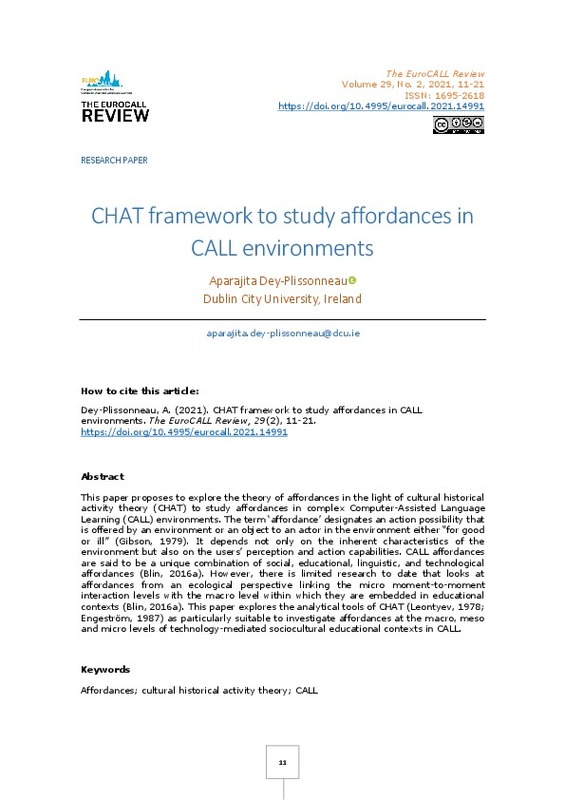Albrechtsen, H., Andersen, H. H. K., Bødker, S., & Pejtersen, a. M. (2001). Affordances in Activity Theory and Cognitive Systems Engineering. Learning (Vol. 1287).
Baerentsen, K. B., & Trettvik, J. (2002). An activity theory approach to affordance. In Proceed- ings of the second Nordic conference on human-computer interaction (pp. 51-60). New York: Association for Computing Machinery. https://doi.org/10.1145/572020.572028
Bakhtin, M. M. (1981). The Dialogic Imagination: Four Essays by M. M. Bakhtin. Austin: University of Texas Press.
[+]
Albrechtsen, H., Andersen, H. H. K., Bødker, S., & Pejtersen, a. M. (2001). Affordances in Activity Theory and Cognitive Systems Engineering. Learning (Vol. 1287).
Baerentsen, K. B., & Trettvik, J. (2002). An activity theory approach to affordance. In Proceed- ings of the second Nordic conference on human-computer interaction (pp. 51-60). New York: Association for Computing Machinery. https://doi.org/10.1145/572020.572028
Bakhtin, M. M. (1981). The Dialogic Imagination: Four Essays by M. M. Bakhtin. Austin: University of Texas Press.
Blin, F. (2005). CALL and the devlopment of learner autonomy: an activity theoretical study. Institute of Educational Technology, The Open Universiy.
Blin, F. (2016). The theory of affordances. In C. Caws & M. Hamel (Eds.), Language-Learner Computer Interactions: Theory, methodology and CALL applications. Amsterdam; Philadelphia: John Benjamins Publishing. https://doi.org/10.1075/lsse.2.03bli
Blin, F., Nocchi, S., & Fowley, C. (2013). Mondes virtuels et apprentissage des langues : Vers un cadre théorique émergent. Recherches et Applications, (54), 94-107.
Blunden, A. (2010). An Interdisciplinary Theory of Activity. Leiden, Boston: BRILL. https://doi.org/10.1163/ej.9789004184060.i-344
Blunden, A. (2015). Leontyev's Activity Theory and Social Theory. Retrieved April 9, 2018, from https://www.ethicalpolitics.org/ablunden/pdfs/Leontyev and Social Theory.pdf
Bonderup Dohn, N. (2009). Affordances revisited: Articulating a Merleau-Pontian view. International Journal of Computer-Supported Collaborative Learning, 4(2), 151-170. https://doi.org/10.1007/s11412-009-9062-z
Cole, M. (1988). Cole-1988-Cross-cultural-research-socio-historical-tradition.pdf. Human Development, 31(3), 137-157. https://doi.org/10.1159/000275803
Conole, G., & Dyke, M. (2004). What are the affordances of information and communication technologies? ALT-J, 12(2), 113-124. https://doi.org/10.3402/rlt.v12i2.11246
Dalgarno, B., & Lee, M. J. W. (2010). What are the learning affordances of 3-D virtual environments? British Journal of Educational Technology, 41(1), 10-32. https://doi.org/10.1111/j.1467-8535.2009.01038.x
Darhower, M. A. (2008). The role of linguistic affordances in telecollaborative chat. Calico Journal, 26(1), 48-69.
De Haan, J., Reed, W. M., & Kuwada, K. (2010). The effect of interactivity with a music video game on second language vocabulary recall. Language Learning & Technology, 74(2), 74-94.
Engeström, R. (1995). Voice as Communicative Action. Mind, Culture, and Activity, 2(3), 192-214. https://doi.org/10.1080/10749039509524699
Engeström, Y. (1987). Learning by Expanding: An Activity-Theoretical Approach to Developmental Research. Helsinki: Finland: Orienta-Konsultit, Oy. https://doi.org/10.1017/CBO9781139814744
Engeström, Y. (1999). Communication, Discourse and Activity. Communication Review, 3(1/2), 165-186. Retrieved from http://web.b.ebscohost.com.dcu.idm.oclc.org/ehost/detail/detail?vid=0&sid=54c035b1-f79f-40b4-977a-cddcf9022f98%40pdc-v-sessmgr05&bdata=JnNpdGU9ZWhvc3QtbGl2ZQ%3D%3D#AN=4114913&db=cms
Engeström, Y. (2001). Expansive Learning at Work: Toward an activity theoretical reconceptualization. Journal of Education and Work, 14(1), 133-156. https://doi.org/10.1080/13639080123238
Engeström, Y. (2005). Developmental work research: expanding activity theory in practice. Berlin: Lehmanns Media. https://doi.org/10.1002/0471142735.ima03bs111
Engeström, Y. (2008). From teams to knots: Activity theoretical studies of collaboration and learning at work. Cambridge: Cambridge University Press. https://doi.org/10.1017/CBO9780511619847
Engeström, Y., Miettinen, R., & Punamäki, R.-L. (1999). Perspectives on Activity Theory. Cambridge: Cambridge University Press. https://doi.org/10.1017/CBO9780511812774
Engestrom, Y., & Sannino, A. (2010). Studies of expansive learning: Foundation, findings and future challenges. Educational Research Review, 5, 1-24. https://doi.org/10.1016/j.edurev.2009.12.002
Gibson, E. J., & Pick, A. D. (2000). An Ecological Approach to Perceptual Learning and Development. Cary, USA: Oxford University Press.
Gibson, J. J. (1979). The Ecological Approach to Visual Perception. New York: Psychology Press, Taylor & Francis Group.
Kaptelinin, V., & Nardi, B. (2012). Affordances in HCI: Toward a mediated action perspective. In Proceedings of the 2012 ACM Annual Conference on Human Factors in Computing Systems (pp. 967-976). New York: Association for Computing Machinery. https://doi.org/10.1145/2207676.2208541
Kirschner, P., Strijbos, J., Kreijns, K., & Beers, P. J. (2004). Designing electronic collaborative learning environments. Educational Technology Research and Development, 52(3), 47-66. https://doi.org/10.1007/BF02504675
Kuutti, K. (1996). Activity Theory as a potential framework for Human-Computer Interaction research. In B. Nardi (Ed.), Context and Consciousness: Activity Theory and Humn-Computer Interaction (pp. 17-44). Cambridge, MA: The MIT Press.
Laurillard, D., Stratfold, M., Luckin, R., Plowman, L., & Taylor, L. (2000). Affordances for Learning in a Non-Linear Narrative Medium. Journal of Interactive Media in Education, 2, 1-19. https://doi.org/10.5334/2000-2
Lektorsky, V. (2004). Science, Society and Ethics. Poznan Studies in the Philosophy of the Sciences and the Humanities, 81, 229-232.
Leontyev, A. N. (1978). Activity and Consciousness. (Andy Blunden, Ed.). CA, USA: Marxists Internet Archive. https://doi.org/10.1103/PhysRevC.18.1688
Leontyev, A. N. (1981). Problems of the development of the mind. Moscow: Progress.
Levy, M., & Caws, C. (2016). CALL design and research. Taking a micro and macro view. In C. Caws & M.-J. Hamel (Eds.), Language-Learner Computer Interactions: Theory, methodology and CALL applications (pp. 89-113). Amsterdam; Philadelphia: John Benjamins Publishing. https://doi.org/10.1075/lsse.2.05lev
Lin, A. M. Y. (2007). What's the Use of 'Triadic Dialogue'?: Activity Theory, Conversation Analysis and Analysis of Pedagogical Practices. Pedagogies: An International Journal, 2(2), 77-94. https://doi.org/10.1080/15544800701343943
Nocchi, S. (2017). The affordances of virtual worlds for language learning.
Reimann, R. (2001). So you want to be an interaction designer… Retrieved May 1, 2021, from https://www.researchgate.net/publication/247561586_So_you_want_to_be_an_interaction_designer
Turner, P. (2005). Affordance as context. Interacting with Computers, 17(6), 787-800. https://doi.org/10.1016/j.intcom.2005.04.003
Van Lier, L. (2000). From input to affordance: Social-interactive learning from an ecological perspective. In J. P. Lantolf (Ed.), Sociocultural theory and second language learning (pp. 245-259). Oxford: Oxford University Press.
Vyas, D., Chisalita, C. M., & Dix, A. (2008). Dynamics of affordances and implications for design (Report).
Vygotsky, L. S. (1986). Thought and Language (A. Kozulin, Ed., Trans.). Cambridge, MA: MIT Press.
Wertsch, J. V. (1991). Voices of the Mind: A Sociocultural Approach to Mediated Action. Cambridge, Massachusetts: Harvard University Press.
[-]









